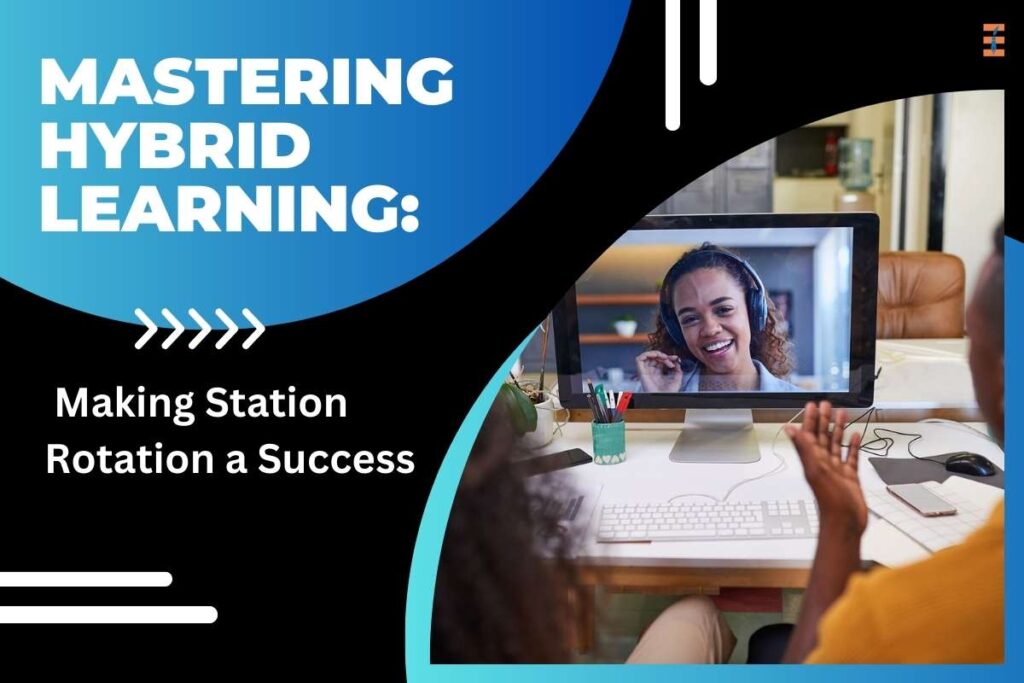Hybrid learning, This innovative pedagogical approach seamlessly fuses traditional classroom instruction with the vast potential of online learning elements. The station rotation model has emerged as one of the most effective blends of learning techniques.
The station rotation model is not merely a teaching technique; it’s a pedagogical strategy that has gained prominence for its ability to make hybrid learning not just effective but engaging and adaptable.
This model artfully combines face-to-face interactions in the physical classroom with carefully curated online activities, resulting in a structured and flexible learning environment.
In this exploration, we will delve deep into the various components and strategies that can empower educators to harness the full potential of the station rotation model within the context of hybrid learning.
Let’s start this journey by uncovering the nuances, benefits, and best practices that will enable educators to seamlessly integrate station rotation into their hybrid teaching toolkit.
A New Frontier
Hybrid learning combines the best of both worlds – in-person interaction and the flexibility of online resources. It allows students to learn at their own pace while still benefiting from face-to-face instruction. To harness the full potential of this approach, educators can employ station rotation, a dynamic strategy that involves students moving through various learning stations, each with its own focus.
1. Clearly Define Learning Stations

To make station rotation work during blended learning, it’s crucial to define the purpose and content of each learning station. Ensure that students understand what they should achieve at each station. This clarity helps maintain focus and engagement.
2. Create Engaging Online Activities
One key element of station rotation is online activities. These should be interactive, engaging, and directly related to the learning objectives. Consider using multimedia resources, quizzes, or discussion forums to keep students active and interested.
3. Foster Collaboration
This learning doesn’t mean students work in isolation. Encourage collaboration by designing stations that involve group discussions or projects. Tools like video conferencing platforms can facilitate meaningful interactions among remote and in-person learners.
4. Provide Clear Instructions
Effective communication is essential in compound learning. Ensure that students have clear instructions for each station, including how to access online materials and how to transition between stations. Clarity reduces confusion and empowers students to take control of their learning.
Station Rotation in Action
Now, let’s explore how station rotation can be applied effectively during combined learning:
Station 1. Direct Instruction

This station is ideal for introducing new concepts or reviewing essential content. During in-person learning, the teacher delivers instruction and answers questions. For remote learners, recorded videos or live online sessions can serve the same purpose.
Station 2. Collaborative Group Work
At this station, students collaborate on projects, discussions, or problem-solving tasks. Group work can be facilitated through video conferencing tools or online platforms that allow for real-time collaboration.
Station 3. Independent Practice
Here, students apply what they’ve learned through online activities or assignments. Ensure that the tasks align with the learning objectives and provide opportunities for self-assessment and reflection.
Station 4. Online Exploration
In this station, students explore online resources related to the topic. This could include interactive simulations, virtual field trips, or multimedia presentations. Online exploration encourages independent inquiry and curiosity.
Station 5. Assessment and Feedback
At this station, students demonstrate their understanding through assessments. These could be quizzes, written responses, or project submissions. Timely feedback is crucial to guide their learning journey.
Station 6. Reflection and Goal Setting

Incorporate time for reflection and goal setting into your hybrid learning model. Students can assess their progress, set learning objectives, and identify areas where they need further support.
Station 7. Rotation and Transition
Smooth transitions are essential in station rotation. Clearly outline how students will move between stations, whether they are in the physical classroom or learning remotely. Online platforms can provide schedules and notifications to ensure everyone stays on track.
Benefits and Challenges
As with any teaching method, there are both benefits and challenges to implementing station rotation in hybrid learning:
Benefits of Station Rotation in Hybrid Learning:
1. Personalized Learning
Station rotation allows students to work at their own pace, catering to individual learning styles and needs.
2. Flexibility
Hybrid learning offers flexibility, enabling students to access resources and engage with peers from anywhere.
3. Active Engagement
A variety of learning stations keeps students engaged and motivated throughout the learning process.
4. Blended Learning
Station rotation seamlessly blends face-to-face and online learning, creating a balanced approach.
Challenges of Station Rotation in Hybrid Learning:
1. Technology Requirements
Access to technology and a stable internet connection is essential for hybrid learning, which may not be available to all students.
2. Teacher Training
Educators may require training to effectively use online tools and manage station rotation.
3. Time Management
Coordinating station rotations and transitions can be time-consuming, especially in larger classes.
4. Assessment and Monitoring
Assessing student progress and ensuring they are on task during independent work can be challenging in remote settings.
Conclusion
Hybrid learning is here to stay, offering a dynamic blend of in-person and online education. By implementing station rotation effectively, educators can maximize the benefits of this approach. Clearly defined learning stations, engaging online activities, collaboration, and effective communication are keys to success.
Remember that station rotation is not a one-size-fits-all approach. It can be adapted to suit the needs of your students and the content you’re teaching. With thoughtful planning and a commitment to creating a supportive and engaging learning environment, station rotation can become a powerful tool in your hybrid teaching toolkit. So, embrace the possibilities of hybrid learning and make station rotation work seamlessly for your student’s success.
Also Read: Using Blended Learning In Professional Development: A Modern Approach To Skill Enhancement










